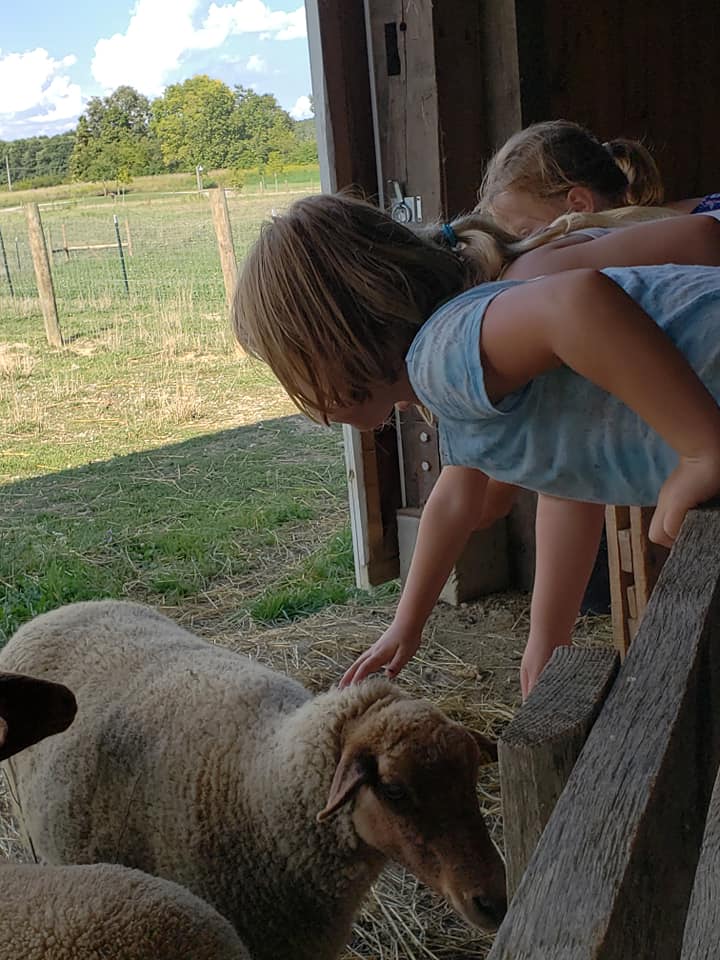By Robin Mayes, Farm Educator

Don’t let anyone pull the wool over your eyes because I am a dyed-in-the-wool admirer of this wonder fiber. It is the topic on my mind as I sit here at my desk wool-gathering.
Wool has been so woven into the history of human that idioms regarding it have made their way into our daily language. This versatile fiber has been keeping humans warm and dry for centuries.
The processing of wool was such a common daily task in the past that the tools used to turn the fibers into yarn are also part of our vernacular. Think of the spinning wheels that played roles in fairy tales or nursery rhymes. The lowly yarn winder has been immortalized in the children’s song, “Pop! Goes the Weasel” The spoked wheel measuring device would make a popping sound when a full skein of yarn was wound onto it, thus, inspiring the song.
A woman (traditionally most spinning was done by women) would need to spin almost constantly to provide the necessary materials needed for the family to be clothed during their lives. And it could even be an important social factor, like quilting bees, except even more vital. We get the idea of “spinning tales” from this image of women exchanging stories and gossip as they spun thread and yarn.
The word spinster has become synonymous with an “unmarried woman who is no longer young and seems unlikely to ever marry.” But historically it referred to any woman who literally spun wool into yarn or thread for a living. The term dates to the 14th-century. Because an adult daughter still living at home would be able to spend much time spinning and contributing to the fiber needs of the family, the word became synonymous with unmarried women.
 Wool gathering has become synonymous with indulgence in idle daydreaming, but at one time it was a vital activity. In the past, sheep roaming the hills shed their wool. People gathered it from where it had caught on bushes and trees. Over time, human bred the sheep to retain their wool so it could be removed all at once with shears.
Wool gathering has become synonymous with indulgence in idle daydreaming, but at one time it was a vital activity. In the past, sheep roaming the hills shed their wool. People gathered it from where it had caught on bushes and trees. Over time, human bred the sheep to retain their wool so it could be removed all at once with shears.
Different breeds of sheep provide differing types of wool. The wool of some is softer. The wool of others has longer fibers, easier to spin. Different types of wool are used for different products like clothing, outerwear, bedding, or carpets. Its flame retardant quality even makes it a choice for firefighter’s uniforms.
 Historically, during the 1930’s, there were more sheep in Ohio than any other state east of the Mississippi. These flocks were kept almost solely for wool production rather than for meat. Families used what wool they needed, and the rest went into the wool co-op to be sold for profit.
Historically, during the 1930’s, there were more sheep in Ohio than any other state east of the Mississippi. These flocks were kept almost solely for wool production rather than for meat. Families used what wool they needed, and the rest went into the wool co-op to be sold for profit.
The creation of synthetic fibers in modern times caused wool to lose value as a commodity, but it is now enjoying a resurgence of popularity. People and manufacturers have rediscovered the appeal of this amazing fiber so more and more products are now available.

Why not come out to Gallant Farm and meet our flock of wool growers? Through the end of February, we are also featuring a display of ‘All Things Wool’ in the granary classroom. We would love to see you. Gallant Farm is open Thursday – Sunday, 12 p.m. – 5 p.m. through April 30.







